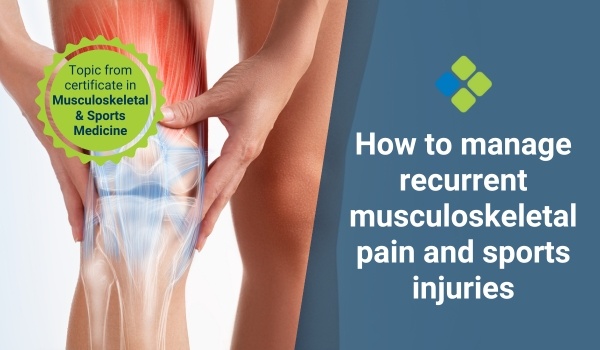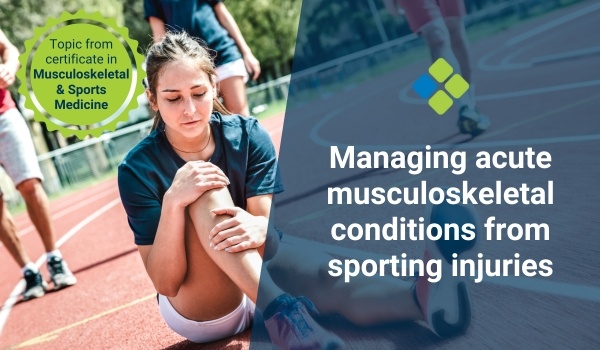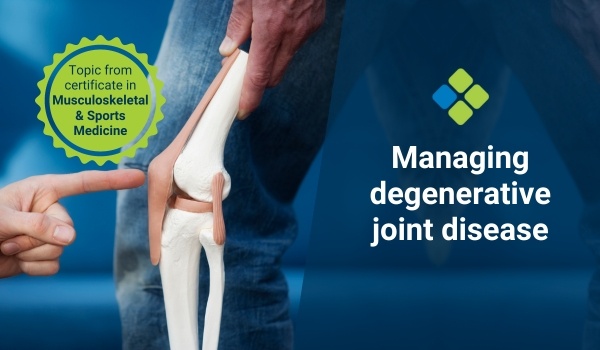How to manage recurrent musculoskeletal pain and sports injuries
Read more about strategies and guidelines to prevent persistent musculoskeletal pain and recurrent sporting injuries in your highly active patients.

HealthCert Education
Your physically fit patients may routinely engage in high-impact sporting activities. Although these activities are generally good for their physical health, patients sometimes report persistent or recurrent musculoskeletal (MSK) pain from multiple body sites.
Recurrent musculoskeletal pain negatively impacts athletes’ daily life, self-care, mental state, and quality of life. Musculoskeletal pain in athletes requires special consideration as it affects their ability to return to sport.
Sports-related musculoskeletal pain is closely linked to the bio-psychosocial model, including physical/psychological factors and environmental and social factors. The athlete is predominantly concerned about returning to sports with optimal strength.
To manage recurrent musculoskeletal pain, it is crucial to understand the factors that aid in transitioning acute musculoskeletal pain to chronic persistent pain.
Risk factors for recurrent musculoskeletal pain
Certain modifiable and non-modifiable risk factors contribute to chronic musculoskeletal pain.
The most common non-modifiable risk factor is age; adolescents and young children tend to sustain acute sports-related injuries, whereas athletes in the middle-aged group develop recurrent, persistent pain.
Modifiable risk factors are more inclined towards contextual and psychological factors such as:
- PTSD
- Fear-avoidance behaviour
- Heightened perception of pain
- Relating pain to traumatic events
- Fear of dependency
- Fear of not being able to return back to sport
- Chronic depression
Medical professionals should identify these potential risk factors and treat the musculoskeletal pain at all levels (preventive/conservative, primary, secondary, and tertiary levels).
Guidelines to prevent recurrent, sports-related musculoskeletal pain
Sporting injuries can be prevented by incorporating a targeted exercise program that trains the athlete for specific activities. Using a prophylactic approach, clinicians and physiotherapists can prevent and minimise recurrent musculoskeletal pain in athletes.
Education and awareness
It is important to educate athletes about their condition and the severity of their pain so they know when to consult their healthcare provider for proper care and treatment.
Pre-screening and assessment
Athletes should be pre-screened before enrollment in high-impact sporting activities so that the clinician, physiotherapist, and trainer can better understand the athlete’s activity level. This minimises the chance of sports injury.
Specialised training programs
Every athlete is unique, and a one-size-fits-all training program is not sufficient. While the goal may be the same, the training process should be tailored to each individual. Personalised training programs are designed to help athletes reach their full potential and achieve their goals.
Activity monitoring
The physical therapist constantly monitors and assesses the athlete’s activity level to identify MSK-related issues and devise a treatment plan.
Assessing psychological wellbeing
Studies have suggested that a myriad of musculoskeletal problems are deeply associated with the psychological wellbeing of athletes. It is imperative to clinically address these issues if an athlete is suffering from depression or fear of failing.
Critical points to prevent recurrent pain in athletes
- The athlete's exercise program should include exercises of other muscle groups, cross-training, and global exercises.
- Athletes should use proper body biomechanics while using equipment or gear and take guidance from their trainer.
- Athletes should learn the correct sport techniques from a coach.
- Before engaging in sports activities, athletes should always follow a warm-up routine.
- It is important to gradually increase the activity level from moderate to high intensity to ensure the athlete's body can adapt to the demands of the sport, reducing the risk of injury and allowing them to perform at their best.
- Athletes should always consult a physiotherapist and undergo a clinical assessment. A physiotherapist will work with them to design a comprehensive exercise program that includes posture corrective exercises, specific muscle group stretching and strengthening, endurance training, and progressive resistance training. This approach helps ensure they can perform at their best and stay injury-free.
- Dr Humda, Physiotherapist
Learn more about this topic in the HealthCert Professional Diploma program in Musculoskeletal & Sports Medicine - fully online or with optional practical workshops.
Engaging with this blog can help meet your annual
|
|
If you consume educational webinars, podcasts, articles, or research on this blog, you can Quick Log CPD hours with the RACGP via the usual self-submission process. You will be asked to reflect on what you have learned, and you will require supporting evidence such as a screenshot. |
References
- https://www.ncbi.nlm.nih.gov/pmc/articles/PMC9367909/
- https://www.ncbi.nlm.nih.gov/pmc/articles/PMC8939173/
- https://pubmed.ncbi.nlm.nih.gov/28827314
- https://pubmed.ncbi.nlm.nih.gov/24463910

 1800 867 1390
1800 867 1390







